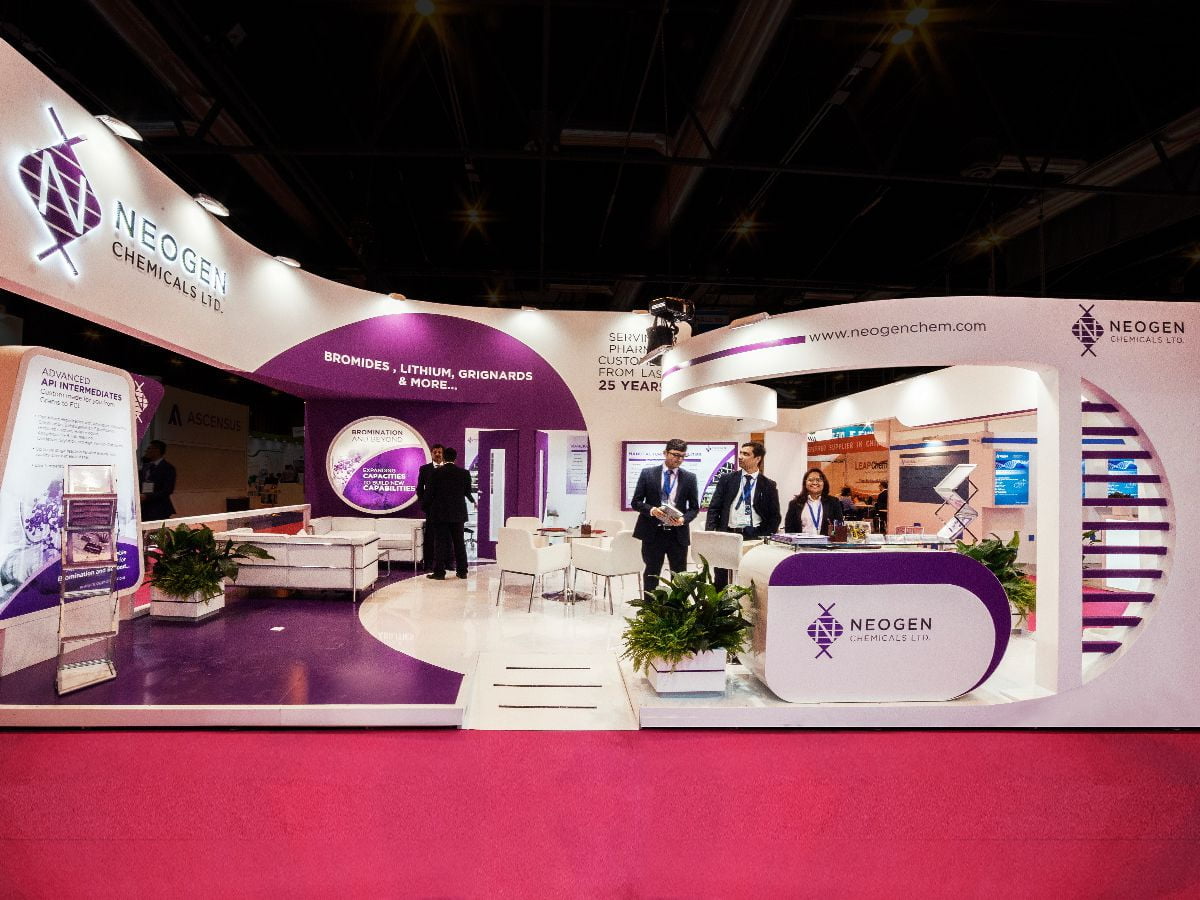Expo Stand Designs

Fabric Exhibition Stands
A successful expo stand design should not only capture the attention of visitors but also leave a lasting impression that can help to generate leads.

Expo Show Booth Designs
The design should be visually appealing, incorporating the company's brand colors and logo, and should also be functional and easy to navigate.

Portable Display Stands
Expo stand designs are essential for creating an impactful and memorable presence at expos and exhibitions.
The use of technology, such as virtual and augmented reality, in expo stand design
The use of technology, such as virtual and augmented reality, has revolutionized the way exhibitors approach expo stand design. In the past, exhibitors relied on physical displays and materials to showcase their products and services. However, with the advent of new and innovative technologies, exhibitors can now create immersive and interactive experiences that engage attendees in new and exciting ways.
1. Ability to create highly personalized experiences for attendees
One of the key benefits of using virtual and augmented reality in expo stand design. is the ability to create highly personalized experiences for attendees. For example, virtual reality allows exhibitors to create interactive environments where attendees can explore products and services in a 360-degree environment. This not only engages attendees, but it also provides a unique and memorable experience that sets exhibitors apart from the competition.
2. Enhance physical displays
Augmented reality, on the other hand, allows exhibitors to enhance physical displays by adding digital elements, such as animations, graphics, and video. This technology offers a fun and interactive way for attendees to learn about products and services, and it also provides exhibitors with valuable data on attendee engagement and behavior.
3. Ability to create eco-friendly and sustainable displays
Another advantage of using virtual and augmented reality in expo stand design is the ability to create eco-friendly and sustainable displays. Physical displays can be costly and resource-intensive, and they often require shipping and storage, which can be a strain on the environment. With virtual and augmented reality, exhibitors can create displays that are both sustainable and cost-effective, as they do not require shipping or storage, and they can be reused and repurposed for future events.
4. Engaging and enjoyable experience
In addition to the benefits for exhibitors, virtual and augmented reality also offer attendees a more engaging and enjoyable experience at events. Attendees are able to explore and interact with products and services in a way that is not possible with traditional physical displays. This not only enhances the overall experience, but it also helps to increase attendee engagement and build brand loyalty.
5. The cost of implementing virtual and augmented reality
Despite the many benefits of using virtual and augmented reality in expo stand design., there are also some challenges that exhibitors must be aware of. One of the biggest challenges is the cost of implementing virtual and augmented reality technology, which can be substantial. In addition, exhibitors must also have the technical expertise and resources to create and manage these displays, which can be a challenge for some exhibitors.
6. Accessible and inclusive
Another challenge is ensuring that virtual and augmented reality displays are accessible and inclusive for all attendees. This means that exhibitors must consider the technical requirements of their displays, such as compatibility with various devices and operating systems, as well as accessibility features for attendees with disabilities.
7. Impact on expo stand design
Additionally, virtual and augmented reality can also be used to create virtual events and expos, which can have a significant impact on expo stand design. Virtual events allow exhibitors to reach a wider audience, as attendees can participate from anywhere in the world. This can help to reduce the carbon footprint of events and make them more accessible for attendees.
8. Use of data and analytics
Another way in which technology has impacted expo stand design is through the use of data and analytics. With virtual and augmented reality displays, exhibitors can collect valuable data on attendee engagement and behavior, such as the amount of time attendees spend exploring a display, which products and services are most popular, and how attendees interact with digital elements. This data can be used to improve future displays and ensure that exhibitors are creating experiences that resonate with attendees.
9. Overall event experience
Finally, exhibitors must also be mindful of the impact of virtual and augmented reality on the overall event experience. While these technologies can enhance the overall experience, they can also be distracting and overwhelming for some attendees, and exhibitors must find a balance between technology and personal interaction.
In conclusion, the use of virtual and augmented reality in expo stand design offers many benefits for exhibitors and attendees. However, exhibitors must be mindful of the challenges and find creative and innovative ways to create impactful and memorable experiences for attendees, while also considering the sustainability and cost-effectiveness of their displays. As technology continues to evolve, it is important for exhibitors to stay ahead of the curve and embrace new and innovative approaches to expo stand design.
Happy Exhibiting!
Mind Games: How Expo Stand Designs Influence Your Customers
Have you ever walked into an expo and felt an almost magnetic pull towards a particular stand? That, my friends, is not by accident. Expo stand designs are the unsung heroes of marketing, orchestrating a symphony of colours, shapes, and stories to captivate your senses and command your attention. They are the architects of impressions, the magicians of emotions, and the narrators of unforgettable tales.
Join us on an extraordinary journey where psychology and strategy merge to create an irresistible force. As we explore the hidden facets of expo stand design psychology, you’ll discover how to master the art of capturing hearts and minds, one booth at a time. Expo stand designs are not just structures; they are the gateway to an extraordinary adventure and the key to unlocking your event’s true potential.
Measuring Minds: The Real Impact of Expo Stand Designs on Visitors
Let’s take a journey into the bustling world of expos and fairs, where the spotlight shines on captivating expo stand designs. These seemingly ordinary structures wield a remarkable power, silently influencing the decisions of visitors. It’s time to uncover the real impact of expo stand designs and explore the mind games they play.
Making Heads Turn
The power of expo stand designs can’t be overstated. It’s the law of attraction in action. Just as a magnet draws metal, a well-designed expo stand can pull in visitors. But it’s not magic; it’s science. Think of your stand as a piece of art.
It’s all about balance, symmetry, and proportion. These elements work together to create a harmonious design that naturally draws people in. Your stand is not just an arrangement of materials; it’s a masterpiece that guides visitors’ eyes and keeps them engaged.
The FOMO Effect
Fear of Missing Out (FOMO) is a powerful motivator, and your expo stand design can harness this fear. Think about it like this: you’re offering something exclusive, something that’s available only at the fair, and visitors can’t help but feel they might miss out on a fantastic opportunity.
Imagine you’re an illusionist, and your stand is your stage. Limited-time offers exclusive products, or unique experiences become your magical tricks. The sense of urgency draws visitors in, and they can’t resist the allure of what’s right before their eyes.
Building Trust with Expo Stand Designs
We are inherently social beings, and our decisions often hinge on what others do. Expo stands can tap into this by showcasing social proof – evidence that others have benefited from your products or services. Think of your expo stand as a gallery of trust.
Display customer testimonials, awards, and endorsements prominently within your design. These are the badges of honour that reassure visitors of your credibility. It’s like having a room full of nods and smiles from happy customers, all saying, “This is the real deal.”
Decoding the Mind Games: Psychological Insights of Expo Stand Designs
Now that we’ve explored the mesmerising world of expo stand designs and their actual impact, it’s time to dive deeper into the mind games they play. These psychological insights are like hidden keys that unlock the potential of your expo stand to attract and engage visitors. Let’s decode these insights and unveil the secrets behind successful expo stand designs.
1. The Law of Attraction: Why Visitors Can’t Resist Your Expo Stand
Imagine your expo stand as a magnet, drawing visitors in like a moth to a flame. Your stand’s design should be a visual masterpiece, capturing attention from a distance. It’s all about creating a magnetic pull that’s impossible to resist.
Key Points:
- Balance and Symmetry: A well-balanced design with symmetry is aesthetically pleasing and naturally draws people in. Think of it as the visual equivalent of a harmonious melody.
- Proportion Matters: Use proportion to guide visitors’ eyes and keep them engaged. It’s like a visual roadmap that takes them on a journey through your booth.
2. The Scarcity Effect: The Fear of Missing Out
Picture this: your expo stand features a limited-time offer, a unique product, or an exclusive experience. It is the scarcity effect at work. People fear missing out on something great, and your booth is the place to be.
Key Points:
- Limited-Time Offers: Create a sense of urgency by offering deals or experiences that are only available at the expo. It’s like a flash sale that visitors can’t resist.
- Exclusivity: Make visitors feel like VIPs by offering products or services they won’t find anywhere else. The exclusivity factor can be a powerful motivator.
3. Social Proof and Credibility: Trust Is the Key
We’re social creatures, and what others do greatly influences our decisions. Expo stands can tap into this by showcasing social proof – evidence that others have benefited from your products or services.
Key Points:
- Customer Testimonials: Display testimonials from satisfied customers to reassure visitors that your offerings are worth their attention and trust.
- Awards and Endorsements: If your expo stand has received accolades or endorsements, don’t hide them. Flaunt them! They’re like badges of honour that build credibility.
So, here’s the scoop: expo stand designs are not just about pretty visuals; they’re about understanding how our minds work and using that knowledge to your advantage. These psychological insights are the keys to creating an expo stand that stands out from the crowd, attracts visitors like a magnet, and leaves a lasting impression.
Your Turn to Play: Applying Expo Stand Designs Psychology to Transform Your Events
Now that you’re armed with a deep understanding of the psychology behind expo stand designs, it’s time to roll up your sleeves and put this knowledge into action. Transforming your events with captivating expo stand designs is an art, and here’s your paintbrush and canvas.
1. Know Your Audience: The Heartbeat of Expo Success
Your expo stand doesn’t exist in a vacuum. It lives, breathes, and thrives with your audience. So, before you start sketching your expo stand design, get to know your audience inside out
Why? Because an expo stand design that resonates with your audience is a powerful magnet that draws them in.
Take time to research your target audience’s preferences, interests, and pain points. Understand what makes them tick, what keeps them awake at night, and what gets them excited. When your expo stand design speaks directly to their hearts, you’re one step closer to success.
2. Create a Compelling Theme: The Spark That Ignites Interest
What makes a story unforgettable? It’s the theme that binds it all together. Your expo stand design should be no different. Think of your theme as the spark that ignites interest and curiosity.
Why? Because a compelling theme is the secret ingredient that sets your expo stand apart from the crowd.
Brainstorm and unleash your creativity to craft a theme that resonates with your brand and captivates your audience. Weave a narrative into your design, making visitors feel part of a story. A well-thought-out theme ensures your expo stand is not just a random display but a memorable experience.
3. Optimise Visibility: Be the Beacon in the Expo Storm
In the vast ocean of an expo or fair, being invisible is not an option. Your expo stand should be a beacon, guiding visitors toward you. To achieve that, optimise its visibility.
Why? Because visibility is the first step in capturing your audience’s attention.
Use eye-catching graphics, strategic lighting, and signage that stands out. Ensure that your branding and messaging are clear from a distance. When your expo stand can be spotted from across the room, you’ve won half the battle.
4. Use Colour Psychology: The Palette of Emotion
Colours aren’t just hues; they’re powerful tools for evoking emotions. When it comes to expo stand designs, colour psychology can be your secret weapon.
Why? Because the right colour palette can influence visitor moods and behaviour.
Choose colours that align with your brand identity and, more importantly, the emotions you want to trigger. Warm colours like red and orange can create a sense of urgency and energy, perfect for impulse buying. Cool colours like blue and green promote a feeling of calm and trust, making them ideal for brands focusing on reliability and integrity.
5. Engage the Senses: Leave a Lasting Imprint
In the world of expo stand designs, don’t limit yourself to visuals. Engaging multiple senses can make your booth unforgettable.
Why? Because multisensory experiences leave a lasting imprint in your visitors’ memory.
Consider incorporating scents, sounds, and tactile elements into your expo stand. The aroma of freshly baked cookies, a soothing background melody, or a touch-and-feel station can make your booth memorable and distinctive. Engaging all the senses ensures your brand remains etched in your audience’s minds.
The Ultimate Goal: Converting Expo Stand Visitors into Customers
You’ve designed the perfect expo stand; it’s drawing visitors like a magnet, and the atmosphere is buzzing with excitement. But now what? How do you turn those intrigued visitors into delighted customers? Let’s dive into the ultimate goal of expo stand designs – converting visitors into loyal customers.
1. Capture Contact Information – The Expo Stand Goldmine
Every visitor to your expo stand is a potential goldmine for future business. But how do you keep the conversation going once the fair is over? The answer is simple – capture their contact information. Offer something enticing, like a chance to win a prize or access exclusive content, in exchange for their details. It gives you a direct line to reach out and nurture the relationship.
2. Build Relationships – It’s Not Just About the Sale
Don’t make the common mistake of being too sales-oriented at the expo. Instead, focus on building genuine relationships. Start by asking questions and actively listening to your visitors. Understand their needs, concerns, and aspirations. Building trust is the first step in converting a curious visitor into a devoted customer.
3. Follow Up – Strike While the Iron is Hot
The expo might be over, but the excitement doesn’t have to end there. After the event, send personalised follow-up messages. Express your appreciation for their visit, remind them of your conversation, and provide valuable information or insights related to your expo stand designs. Show them you’re committed to meeting their needs and adding value to their lives.
4. Provide Value – Beyond the Expo Stand
Your relationship with fair visitors should be wider than the expo stand. Continue to provide value after the event. Share relevant content, offer educational resources, or send out special promotions. The idea is to keep your brand on their radar and demonstrate that you’re not just interested in making a sale but in providing real solutions.
5. Close the Deal – Make It Irresistible
Finally, offer something irresistible, whether an exclusive discount, a bundle deal, or a limited-time offer. It is the moment where all your relationship-building efforts pay off. Visitors will be more inclined to say ‘yes’ because they trust you, appreciate your value, and see the genuine benefits of your expo stand designs.
So, keep the script engaging, the characters memorable, and the audience captivated. With the right mix of expo stand designs and personalised interactions, you’ll transform curious visitors into delighted customers, and your brand will take centre stage in their lives.
Tomorrow’s Mindsets: Emerging Trends and Psychological Strategies for Expo Stand Designs
It’s an exciting time where innovative trends and powerful psychological strategies are shaping the way we captivate fair attendees and turn them into enthusiastic customers. Let’s explore these emerging trends and techniques that will keep your expo stand ahead of the game.
1. Eco-Friendly and Eye-Catching
The use of eco-friendly materials and practices not only makes a powerful statement but also resonates with eco-conscious visitors. Consider elements like recyclable materials, energy-efficient lighting, and living green walls that create a harmonious blend of sustainability and aesthetics. Showcasing your commitment to the environment can set you apart from the crowd and leave a lasting impression.
2. Turn Fun into Business
Gamification is all about turning your expo stand into an engaging playground. Incorporating games and challenges can transform your fair booth into an entertainment hub. Games not only keep visitors entertained but also encourage them to interact with your brand. From prize wheels to trivia contests, there are countless ways to gamify your booth and make it a destination for fair attendees.
3. Experience with Information
Today, it’s about creating an experience rather than just imparting information. Think about incorporating interactive storytelling elements that immerse visitors in your brand’s narrative. Let them be part of your story, engage with your message, and emotionally connect with your products or services. In a world flooded with information, an engaging experience can make your expo stand unforgettable.
4. Hybrid Experiences
In a world increasingly embracing remote work and virtual events, the line between physical expos and virtual fairs is blurring. Consider creating hybrid experiences that bridge the physical and digital worlds. It may include interactive touchscreens, live streaming, or QR code interactions. By embracing this shift, you can reach a wider audience and ensure your brand is future-ready.
Parting Thoughts: The Endless Potential of Expo Stand Designs Mind Games
As we near the conclusion of our journey into the captivating world of expo stand designs, it’s time to reflect on the endless potential that lies within these remarkable structures. Expo stands are not just temporary installations; they are your gateway to the hearts and minds of your potential customers.
- Your Silent Salesperson – Imagine your expo stand as your most dedicated and persuasive salesperson. It works tirelessly, day and night, attracting visitors, engaging their curiosity, and planting the seeds of desire for your products or services. It’s your opportunity to shine, so make every square inch count.
- It’s an Experience – Your expo stand isn’t merely about what visitors see; it’s about what they experience. Create an ambience that appeals to their senses, engages their emotions, and makes them feel part of your world. It’s a journey that lingers in their memories long after the fair ends.
- Psychology as Your Ally – Understanding the psychology of expo stand designs isn’t just an option; it’s a necessity. Colours, shapes, and spatial arrangements can elicit emotions and influence decisions. Leverage this knowledge to create an environment that captivates and converts.
- The Key to Evolution – The world of expo stand designs is dynamic and ever-evolving. Keep an eye on emerging trends and embrace change. Stay ahead by incorporating new technologies, sustainability, personalisation, and gamification. Adapt to the changing needs and desires of your audience.
- Building Relationships, Not Just Leads – Your expo stand isn’t just a lead-generating machine; it’s a relationship-building platform. Engage in meaningful conversations, listen to your visitors, and understand their needs. Nurture these relationships beyond the fair, and you’ll create lifelong customers.
- Your Brand’s Showcase – Remember, your expo stand isn’t just a booth; it’s your brand’s showcase. It’s where you reveal your passion, innovation, and commitment. Make every inch of it reflect your brand’s personality and values. Let it become a beacon that guides visitors toward your offerings.
Expo stands are more than a one-time event. Learn from each experience, refine your designs, and continue to amaze your audience. The potential of expo stand designs is limitless, and it’s up to you to tap into this boundless reservoir of opportunity.
Conclusion
By understanding the psychology behind these designs and applying the correct principles, you can transform your events into successful marketing endeavours. So, be creative, be strategic, and watch your expo stands become a magnetic force that draws visitors in and converts them into loyal customers.
Are you ready to take your expo stand to the next level and witness the magic for yourself? Contact SOL GmbH today, and let’s embark on this exciting journey together.
Our Portfolio
Contact Us













